
International Research Journal of Engineering and Technology (IRJET) e-ISSN: 2395-0056
Volume: 11 Issue: 07 | July 2024 www.irjet.net p-ISSN: 2395-0072


International Research Journal of Engineering and Technology (IRJET) e-ISSN: 2395-0056
Volume: 11 Issue: 07 | July 2024 www.irjet.net p-ISSN: 2395-0072
Kapalik Khanal1 , Grishma Ojha2 , Sandeep Chataut3 , Umesh Kanta Ghimire 4
1Institute of Engineering, Tribhuvan University, Kathmandu, Nepal
2Oklahoma State University, Stillwater, OK, 74078
3University of South Dakota, Vermillion, USA, 57069
4Head of Department, Institute of Engineering, Thapathali Campus, Kathmandu, Nepal
Abstract - Monitoring soil health is a tedious and timeconsuming task that requires intensive laboratory testing. Soil testing is a multi-step process that involves sample collection, proper packaging, and sending the soil to the nearest laboratory. The entire process requires a significant amount of time and resources and hence, it is not feasible to get real time soil health data from this approach. With the advancements in sensor technologies and data transmission protocols, it is now possible to monitor, collect, extract, analyze, and store real-time in-situ soil health data. In this article, we propose an IoT-based real-time soil health monitoring system using ESP32S3 that can measure soil moisture, electrical conductivity, pH, ultraviolet radiation, temperature, nitrogen, phosphorus, and potassium content of the soil. The system can choose from three communication protocols, Wi-Fi (IEEE 802.11), Global System for Mobile Communications (GSM) and Long Range (Lo-Ra) mesh networking based on their suitability to ensure real-time data transmission from the sensor units to the centralized server. The server also hosts a user-friendly web application interface for real-time visualization of soil parameters. The system is aimed at helping farmers or other stakeholders to take data-driven informed decisions to enhance crop yields inany croppingsystem.
Key Words: soil-sensors, IoT-based, circuit, real-time, precision-agriculture, soil-health, ESP32, low-power
Soil is the most important natural resource and the foundation for life on Earth. Soil supports the entire agriculturalsystemsintheworldandthehealthofthesoil dictates the availability of food for the global population. Soil is composed of minerals, organic matter, water, and air at different proportions. The weathering of the parent rock into fine particles due to its exposure to atmosphere and activity of different gases and water help in the formation of mineral base for the soil [1]. Additionally, microbial activity and plants and animals provide organic matter to the minerals, forming a soil suitable for plant growth and agricultural production [2]. Depending on the type of mineral or parent material involved in the formation of the soiland theamount of organicmatter or nutrient available, the soil properties may vary across
different regions and cause changes in yield [3]. The soil parameters including moisture content, light intensity, nutrients content, Cation Exchange Capacity (CEC), salinity, pH, and soil temperature directly influence the growth and development of crops. Hence, monitoring these variable soil parameters and implementing proper management strategies is vital for successful crop production.

Chart -1:Soilmoisturefluctuationintop5mmlayerof loamsoilon5to7daysafterirrigation[4]
The parameters such as soil moisture content, lux intensity and temperature can fluctuate significantly within a day because of several reasons such as rainfall, solar radiation, evapotranspiration, and soil drainage. Jackson(1973)measuredtheevaporationdynamicsofsoil surface in a loam soil in Arizona by measuring the volumetricwatercontentofthetop5mmofsoilevery30 minutes. The diagram below shows fluctuations in soil moisture content of the top layer of the soil due to daily wettinganddryingcycle[4].
Thesoilnutrient'savailabilityalsovarieswithinagrowing season due to factors including nutrient mineralization and immobilization, leaching, nutrient uptake by plants, andnutrientinputsandlosses.Thenutrientdemandofthe plants is also different at different growth stages [5]. The demand for nitrogen is higher in the plant's vegetative growth stages, whereas the demand for phosphorus and

International Research Journal of Engineering and Technology (IRJET) e-ISSN: 2395-0056
Volume: 11 Issue: 07 | July 2024 www.irjet.net p-ISSN: 2395-0072
potassium increases during the reproductive stages [6]. Hence regular soil testing and monitoring is required for assessing the soil conditions and nutrient levels and implementing precision agricultural practices. However, the time and resource intensive soil sampling and testing procedureisamajorchallengeinthereal-timesoilhealth monitoring. Even though laboratory analysis is more accurate than using sensors, a tradeoff must be made for continuoussoilhealthdata[7].
Advances in technology, particularly in the domain of robotics,artificialintelligence,andmachinelearning,have made it possible to adopt precision agricultural practices by ensuring soil and crop health and eliminating inefficiencies [8]. Use of sensors and IoT technology can significantly help in real-time soil health monitoring by making it possible to collect real-time soil heath data continuously using sensors deployed in the field [9]. IoT platformshelpinintegratingthedatacollectedbymultiple sensors and send it to the centralized location or server for further analysis and the use of advanced analytics algorithms aid in providing valuable insights to the farmers [10]. The proposed system in this study helps in monitoring the real-time soil health parameters using sensorsthatcanbestrategicallyinstalledatdifferentparts ofthefield.Thesensorunitisdesignedtowithstandharsh environmental conditions to ensure long-term field deployment. Multiple communication protocols can be used based on their feasibility for data transmission from sensor units to the centralized server. There are three primary communication protocols, Wi-Fi, GSM and Lo-Ra mesh networking that can be chosen based on the user requirements.Theuseofmultiplemodesofdatacollection ensures reliable data transmission in the varying geographical and infrastructure landscape. For the visualizationandanalysisofthereal-timesoilhealthdata, a user-friendly web application interface has been hosted onthecentralizedserver.
2.1
Soil sensors are vital tools for measuring various soil properties capable of influencing soil health and plant growth. There have been attempts to measure the soil parametersusingdifferentkindsofsensorseitherformapbasedsoilsensingorreal-timesensing.Soilsensorscanbe broadly classified based on their working mechanisms or operating principles. Electrical or electromagnetic sensors areusedtomeasuresoilparametersbasedontheelectrical conductivityorresistivityofthesoil.Examplesofthiskind of sensor include capacitive soil sensors, resistive soil sensors,ElectricalConductivity(EC)sensors,TimeDomain Reflectometry (TDR) sensors, and Frequency Domain Reflectometry(FDR)sensors.Similarly,opticalsensorsuse optical characteristics of the soil for the measurement.
They usually utilize Near-Infrared (NIR) spectroscopy and Visible (VIS) spectroscopy for measuring soil parameters [11]. In a similar manner, mechanical sensors such as penetrometer and tensiometer as well as electrochemical sensors such as conductometric and ion-selective electrodes can also be used to measure several soil parameters [12][13]. However, electromagnetic or electricalsensorsandelectrochemicalsensorsarethemost widely adopted, low cost, and reliable sensors for soil healthmonitoring[14].Electricalsoilsensorstypicallyuse contact electrodes to measure the electrical properties of the soil and correlate them with the corresponding soil parameter being measured [15]. Multi-parameter soil sensors, that can measure multiple soil properties simultaneously, are also used for soil health monitoring [16].Hence,appropriatesoilsensorsareusedwithsuitable communication protocols for continuous and reliable soil healthmonitoring.
Internet of Things (IoT) is a network of interconnected objectsembeddedwithsensorsorsensorunitsor“things” that are capable of exchanging information within the network [17]. These objects can be household appliances, automobiles,andsmartdevicesthathaveauniqueaddress based on a standard communication protocol. IoT enables these objects to collect and transmit data autonomously, facilitating real-time monitoring, control, and optimization of processes across various domains including smart homes, healthcare, agriculture, and manufacturing [18]. IoT plays a vital role in making real-time soil health monitoring possible and has been adopted in several soil healthmonitoring systems.Bhatnagaret al.[19] proposed a soil health monitoring system using IoT that allows farmersinJaipur,Rajasthan,touseanAndroidsmartphone tomonitorsoilmoisture,temperature,andpH,andreceive lime and Sulphur recommendations based on pH levels. Similarly,anotherstudybyRamsonetal.[20]proposedan IoT-based soil health monitoring system using solarpowered units that transmit various soil health metrics wirelessly for continuous in-field monitoring, with data accessiblethroughaweb-baseddashboard.Goswamietal. Alsodevelopeda portable,IoTenabledsoil probeforrealtimeanalysisofsoilmacronutrients(N,P,K),moisture,pH, andhumidity,usingLEDsandLDRfordetection,withdata accessible through a bilingual web interface, aimed at improving farmers' decision-making regarding crop selection,fertilization,and irrigation [21].Sivakumaretal. alsodevelopedasystemwithintegrationofIoTandGISfor real-time soil health monitoring [22]. Similarly, Wu et al proposed a multi-sensor system based on IoT for monitoring soil health with real-time data transmission [23].

International Research Journal of Engineering and Technology (IRJET) e-ISSN: 2395-0056
Volume: 11 Issue: 07 | July 2024 www.irjet.net p-ISSN: 2395-0072
MQTT is a lightweight messaging protocol designed for efficient communication between devices in constrained environments, such as IoT devices. MQTT operates at the application layer of the OSI (Open Systems Interconnection)model.Overtheyears,ithasevolvedinto a widely adopted protocol that provides efficient data exchange in various IoT applications, including smart homes, industrial automation, healthcare, and agriculture [24].Itisadata-agnosticprotocolthatcantransmitdatain variousformatssuchasbinarydata,text,XML,orJSONand usesapublish/subscribemodelratherthanaclient-server model. MQTT uses a publish-subscribe messaging pattern, where clients (publishers) send messages to a central server known as the broker, which then distributes these messages to interested clients (subscribers) based on predefinedtopics[25].

Wi-Fi (Wireless Fidelity) is a technology that allows electronic devices to connect to the internet and communicate wirelessly without the need for physical connection within a Local Area Network (LAN) [26]. The primary bands for operation of Wi-Fi are 2.4 GHz and 5 GHzfrequencybands,andwithrecentadvancementsinthe technology, a 6 GHz band (Wi-Fi 6E) has been introduced. Wi-FiisgovernedbyIEEE802.11familyofstandardandit has different versions such as 802.11a/b/g/n/ac/ax, each having some improvement in speed, range, and efficiency [27]. The ease of deployment and comparatively low cost makes Wi-Fi a preferred choice for both personal and enterprisenetworks.Wi-Fihasalsoproventobeareliable modeofcommunicationforseveralIoTsystems.
GSMisa standarddeveloped to define thecommunication protocols for 2G digital cellular networks used by mobile
phones. It was developed to create a single unified standard for mobile communications in Europe but soon becameaglobalstandardformobilecommunicationdueto itseffectivenessandefficiency.GSMsystemusestwobands ofabout25MHzeachinthefrequencyrangeof890to950 MHz for uplink (mobile to base station) and 935 to 960 MHzfordownlink(basestationtomobile)communication [28]. This usage of two separate bands of frequencies for uplink and downlink communication is also called Frequency Division Duplex (FDD), which ensures simultaneous two-way communication. GSM uses Frequency Division Multiple Access (FDMA) along with FDD. However, instead of having one channel per FDMA carrier, GSM arranges eight channels within a Time Division Multiple Access (TDMA) framework. This means thateach200kHzFDMAchannelisdividedintoeighttime slots, allowing multiple users to share the same frequency channelbytransmittingintheirdesignatedtimeslots[29]. GSMalsointroduceda system tousea Subscriber Identity Module (SIM) card that allowed users to switch mobile phones while retaining their phone number and identity [30]. GSM plays an important role in IoT by providing a power-efficient and reliable means of communication for different IoT devices. As GSM is available globally, it ensures coverage and availability in most of the urban as wellasruralareas.
Lo-Ra is a wireless communication technology, derived from Chirp Spread Spectrum (CSS) technology, and designed specifically for long-range, low-power, low-datarate communication. Due to its properties such as long rangeandlow-powerconsumption,itiswidelyusedinIoT systems[31].Itisawirelessmodulationtechniquethatcan achieve long range communication with low interference and multipath fading. LoRaWAN is often used with Lo-Ra andisaMediaAccessControl(MAC)layerprotocolbuilton top of Lo-Ra. LoRaWAN is a suitable communication protocolandnetwork architecturefortransmissionoffew bytes of sensor data over long communication distances. The LoRaWAN end devices are designed for transmitting signalsoverlongdistancesandconsuminglowpower.This makes this technology a popular choice for IoT systems [32].

International Research Journal of Engineering and Technology (IRJET) e-ISSN: 2395-0056
Volume: 11 Issue: 07 | July 2024 www.irjet.net p-ISSN: 2395-0072
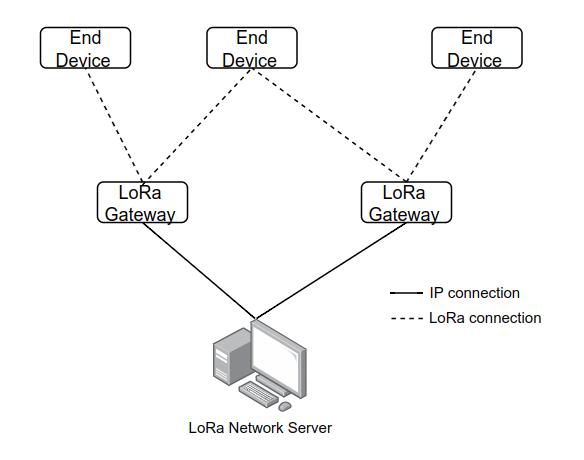
Fig-2:LoRaWANArchitecture
LoRaWAN-based IoT systems have been widely used in precisionagriculturetoo.Silva etal.Used low powerdata acquisition devices in a vineyard at the UTAD University Campus to assess the effectiveness of LoRaWAN technology for systematizing data acquisition in precision agriculture using the mySense framework. The use of LoRaWAN solved the issues with range of data communication and energy budget [33]. Similarly, Soto et al. Also used LoRaWAN for communication in their soil health monitoring system to achieve low power data transmissionfromthesensor[34].Inanotherstudy,asoil moisture monitoring system using LoRaWAN was proposed that utilized Received Signal Strength Indicator (RSSI) and transmission power to indirectly sense the variationsinsoilmoisturelevels[35].
3. METHODOLOGY
3.1 Overall System Design
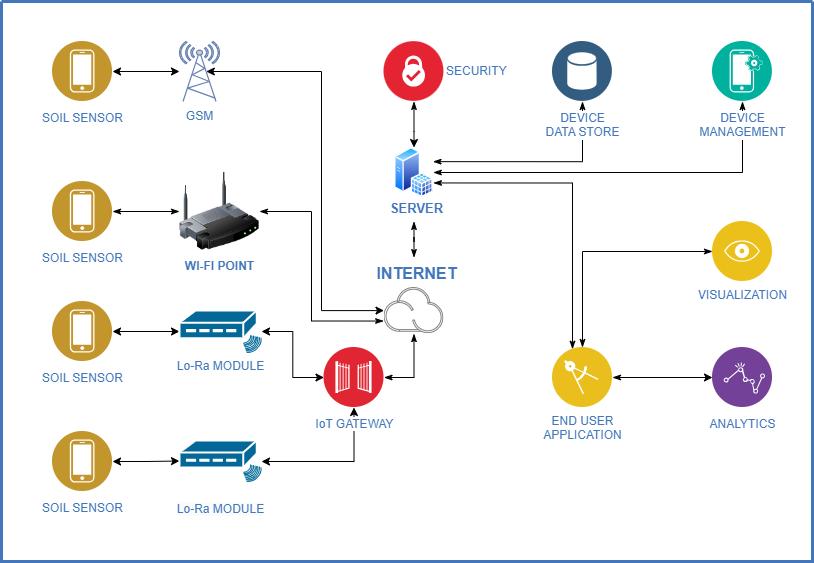
Fig-3:SystemBlockDiagram
Theoverallsystemblockdiagramwithgeneralworkflowof our system has been depicted in the above figure. The sensor units at different locations in the field can communicate with the centralized server using 3 different
communicationprotocols,GSMforthecellularnetworking, Wi-Fiforthelocalareanetworking,andLo-Raforthelong range, low power networking. In the case of LoRaWAN communication, data is collected and communicated throughanIoTgatewaythatcollectsandforwards data to the other macro internet networking system that allows thedatagatheredtobesenttoabaseserver.Inthecaseof Wi-Ficommunication,theinbuiltWi-Fifunctionalityofthe ESP32S3 helps to communicate directly to the central server. On the other hand, for a GSM system, it uses M2M communication to communicate with the server to send andstorethesensordata.Thecentral servertakescareof data storage and sends the data to the connected mobile deviceforreal-timedatavisualizationandanalysis.
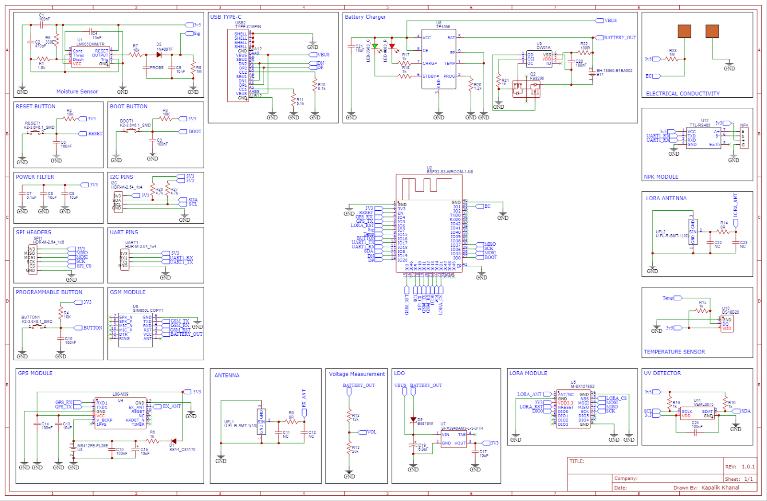
Fig -4:CircuitDiagramofthesystem
Thecircuitdiagramhasallthecomponentsoftheproposed system with multiple communications and sensing interface.AtthecenterofitistheESP32S3microcontroller withinbuiltWi-Fifunctionality.Thepowermanagementin the system is handled through a USB Type-C connector, along with a battery charging circuit for portable use. The LDOregulatorusedinthesystemprovidesastablevoltage supply to all components with very low quiescent current of 9uA. To ensure reliability of the system, the circuit includes reset and boot with debounce circuits, a programmable user button, I2C, SPI, and UART expansion headers.

International Research Journal of Engineering and Technology (IRJET) e-ISSN: 2395-0056
Volume: 11 Issue: 07 | July 2024 www.irjet.net p-ISSN: 2395-0072
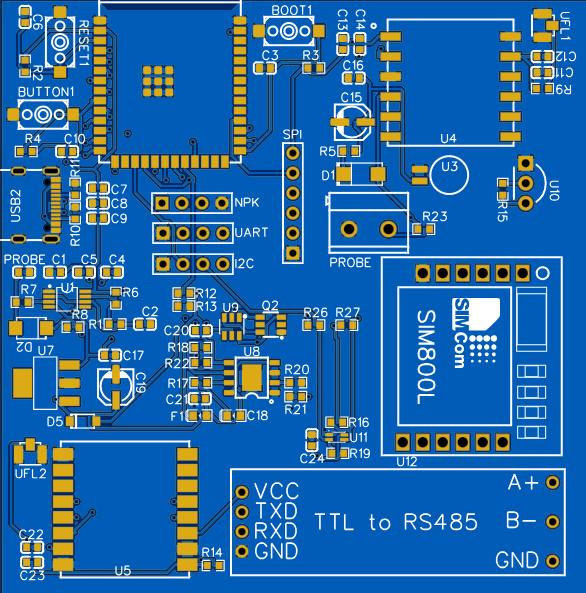
Fig-5:SystemPCBdesign
Specialattentionhasbeenpaidtomaintainsignalintegrity and power supply cleanliness by placing the passive components such as the pull-up/pull-down resistors, bypasscapacitorsandfilteringcomponentsproperlyinthe circuit.
The core of the capacitive moisture sensor is a 555 timer that generates a square wave. The sensor operates based on the change in the soil's dielectric constant with the correspondingchangeinthesoil’smoisturecontent.
The frequency of the square wave generated by the 555 timer depends on R1, R6, C1, C2, and the PROBE capacitance. The oscillation frequency (f) of the 555 timer (inastablemode)isgivenbythefollowingequation.
The ESP32 reads the capacitive moisture sensor's output bymeasuringthefrequencyoftheoutputsignalandcounts signal pulses over a predefined interval, calculating frequency from this count. This frequency is then converted to a moisture level using pre-determined calibrationdata[36].
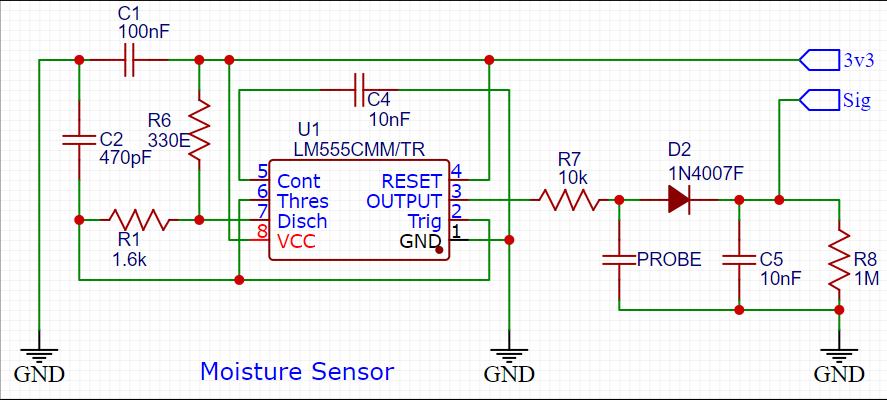
3.2.2
Formeasuringtheelectricalconductivity,twoelectrodesof copperplates,each1cmsquareinsize,with1cmspacing between the plates were buried in the soil to create a voltagedividerwitha1megaohmresistor.

Fig-7:ElectricalConductivitysensorcircuit.
When a 3.3V power source is applied, the soil's conductivityaffectshowthevoltageisdividedbetweenthe resistorandthesoil.Therelationshipbetweenthisvoltage andthesoil'sconductivityisinverselyproportionaltoeach other.
)
Where,VoutisthevoltageatECpin,Vinisthe3.3Vvoltage supply, Rsoil is the resistance of soil, and R is a resistor withafixedvalue.
Also,

International Research Journal of Engineering and Technology (IRJET) e-ISSN: 2395-0056
Volume: 11 Issue: 07 | July 2024 www.irjet.net p-ISSN: 2395-0072
Where,Listhedistancebetweenplates(1cm)andAisthe areaofplates(1 ).Theaboveequationforconductivity becomes:
ThisgivestheconductivityinSiemens/cm.
3.2.1
Similarly, the temperature sensor circuit used in this system uses a DS18B20 digital temperature sensor, and the sensor communicates using the 1-Wire protocol [37]. TheDS18B20providesdirectdigitaltemperaturereadings in Celsius, eliminating the need for analog-to-digital conversion. It uses its in-built 12-bit ADC that converts temperature data into binary format and stores it in a scratchpad memory along with configuration settings and CRC (Cyclic Redundancy Check) for error checking. The Dallas Temperature Library reads this data, checks the CRC value, and converts it to a raw value and the temperatureincentigrade.
3.2.1
The UV detector circuit used in our system uses a VEML6075component[38].TheVEML6075isadigitalUV lightsensorthatmeasuresUVAandUVBradiation.Ituses aphotodiodearraytodetectlightintheUVspectrumand converts this information into a digital signal that can be readbyourESP32microcontroller.
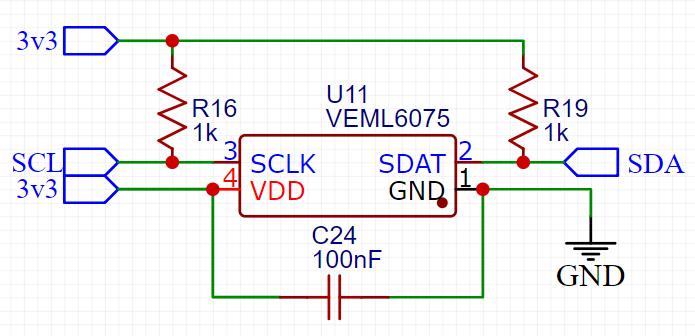
Fig-8
The VEML6075 has separate photodiodes for UVA and UVB radiation which generates current when light falls ontoit.TheanalogsignalsarethenfedintoanADC,which converts them into digital values. These raw values must be converted using specific conversion coefficients. The UVindexisastandardizedmeasurementofthestrengthof ultravioletradiationataparticularplaceandtime.
3.2.1
The NPK soil sensor module uses a combination of ionselective electrodes (ISEs) and a calibration system to
determine the concentration of these nutrients [39]. We used Taidacent RS485 sensor probe for the NPK and pH measurement.TheNPKsensorusesISEsspecifictonitrate (NO3-), phosphate (H2PO4- or HPO42-), and potassium (K+).Thesensorprobes areinsertedintothesoil,andthe electrodes measure the potential generated by nitrate, phosphate, and potassium ions. The sensor's internal microcontroller processes these potentials using the calibrationdatatocalculatetheconcentrationsofN,P,and K levels in the soil. The sensors communicate with the microcontroller using TTL to RS485 converter as sensor outputs in RS485 communication protocol and microcontroller do not accept that protocol. The sensor then sends back a response containing the measurement data.
The real time soil data measured by the sensors is transferredusingtheappropriatecommunicationprotocol to the server. The central server stores the data in the storage and at the same time sends the data to the web applicationforvisualization.Theuserinterfaceoftheweb application displays real-time readings of each soil parameter.Thevisualizationwashighlyinterpretableand user-friendlyandcanbeeasilyunderstoodbyanyone.The graphs below show the sensor data generated by our system. The numbers on the x-axis represent the time on twelve different splits or segments taken at an interval of 1 hour starting at 6 a.m., and the y-axis show the corresponding averaged values obtained from the soil sensor.



International Research Journal of Engineering and Technology (IRJET) e-ISSN: 2395-0056
Volume: 11 Issue: 07 | July 2024 www.irjet.net p-ISSN: 2395-0072

Fig-11:VisualizationofSoilElectricalConductivity (Salinity)inthewebapplication.

Fig-12:VisualizationofSoilTemperaturereadingsinthe webapplication.

Fig-13:VisualizationofSoilpHreadingsintheweb application.

Fig-13:VisualizationofLUXreadingsintheweb application.
A comparative analysis was conducted to assess the accuracy and reliability of the proposed system. The data collectedbyoursensorwascomparedwiththelaboratory soiltestresults.Asoilsamplewascollectedfromthesame site where our system was installed to measure the soil data. We measured the Nitrogen, phosphorus, potassium concentrations and the electrical conductivity of the soil sampleandcomparedthelaboratoryresultswiththedata collectedbyoursystem.
Table -1: Soilparametervaluescomparison.
Parameter
pHLevel 6.8 6
Composition
Nitrogen(N) 83mg/kg 89mg/kg
Phosphorus(P) 51mg/kg 45mg/kg
Potassium(K) 34mg/kg 32mg/kg
Conductivity 189us/cm 197us/cm
We also computed the percent error to analyze how inaccurate the system measurement is, compared to the standardlaboratoryanalysisofsoilparameter.
Table -2: PercentErrorforeachparameter.
pHLevel 11.76%
Composition
Nitrogen(N) 7.23%
Phosphorus(P) 11.76%
Potassium(K) 5.88%
Conductivity 4.23%
It was observed that the soil test results closely match with the results from laboratory analysis of the soil sample. This gives a strong indication that the proposed system is accurately reflecting the soil conditions. However, the system's reliability in field conditions must beassessedforlong-termuse.
Our study shows the potential and practicality of utilizing an IoT-based system for real-time soil health monitoring. By using advanced sensors and communication protocols such as Wi-Fi, GSM, and Lo-Ra, the proposed system can measure soil parameters that include soil pH, electrical conductivity, moisture, ultraviolet radiation, temperature, and key nutrients such as nitrogen, phosphorus, and potassium. The user-friendly web application interface enables effective visualization and analysis of the soil health parameters instantaneously. This system can help take informed, data-driven decisions in agriculture that cansignificantlyenhancecropyieldsandproductivity.Our proposed system addresses the limitations of traditional soil testing methods, offering a more efficient, resourceeffective,andtimelysolutionformonitoringsoilhealth.

International Research Journal of Engineering and Technology (IRJET) e-ISSN: 2395-0056
Volume: 11 Issue: 07 | July 2024 www.irjet.net p-ISSN: 2395-0072
[1] Russell, E. J., & Appleyard, A. (1915). The Atmosphere of the Soil: Its Composition and the Causes of Variation. The Journal of Agricultural Science, 7(1), 1–48. doi:10.1017/S0021859600002410
[2] Johnston, A. E., Poulton, P. R., & Coleman, K. (2009). Soil organic matter: its importance in sustainableagricultureand carbondioxidefluxes. Advancesinagronomy,101,1-57.
[3] Anderson, D. W. (1988). The effect of parent materialandsoildevelopmentonnutrientcycling in temperate ecosystems. Biogeochemistry, 5, 7197.
[4] Jackson, R.D., Diurnal changes in soil water content during drying. Field soil water regime, 1973(fieldsoilwaterr):p.37-55.
[5] Li B, Ma X, Zhao B, Wang L and Ata-Ul-Karim ST (2023) In-season assessment of agronomic nitrogen use efficiency and its components in winter wheat using critical nitrogen dilution curve. Front. Plant Sci. 14:1128799. doi: 10.3389/fpls.2023.1128799
[6] Ye,T.,Li,Y.,Zhang,J.,Hou,W.,Zhou,W.,Lu,J.,...& Li, X. (2019). Nitrogen, phosphorus, and potassium fertilization affects the flowering time of rice (Oryza sativa L.). Global Ecology and Conservation,20,e00753.
[7] Kuang, B., Mahmood, H. S., Quraishi, M. Z., Hoogmoed,W.B.,Mouazen,A.M.,&vanHenten,E. J. (2012). Sensing soil properties in the laboratory, in situ, and on-line: a review. Advancesinagronomy,114,155-223.
[8] Shrestha, S., Ojha, G., Sharma, G., Mainali, R., & Galvin, L. (2024). Automated Grassweed Detection in Wheat Cropping System: Current TechniquesandFutureScope.JournalofPrecision Agriculture-1(1),19-37.
[9] Naik, T. R., Shaikh, K. M., Devaraj, S. V., Doddapujar, S. N., Dheeraj, R. B., Patkar, R., & Baghini, M. S. (2023, January). Environmental testing methodology for real-time soil health monitoringsystem.In2023IEEEAppliedSensing Conference(APSCON)(pp.1-3).IEEE.
[10] Bhatnagar,V.,&Chandra,R.(2020).IoTbased soil health monitoring and recommendation system. Internet of Things and AnalyticsforAgriculture,Volume2,1-21.
[11] Kweon,G.,Lund,E., &Maxton,C. (2013). Soil organic matter and cation-exchange capacity sensingwithon-the-goelectricalconductivityand opticalsensors.Geoderma,199,80-89.
[12] Hemmat,A.,Binandeh,A.R.,Ghaisari,J.,& Khorsandi, A. (2013). Development and field testing of an integrated sensor for on-the-go
measurement of soil mechanical resistance. SensorsandActuatorsA:Physical,198,61-68.
[13] Ali, M. A., Dong, L., Dhau, J., Khosla, A., & Kaushik, A. (2020). Perspective electrochemical sensorsforsoilqualityassessment.JournalofThe ElectrochemicalSociety,167(3),037550.
[14] Adamchuk, V. I., Hummel, J. W., Morgan, M. T., & Upadhyaya, S. K. (2004). On-the-go soil sensors for precision agriculture. Computers and electronicsinagriculture,44(1),71-91.
[15] Corwin, D. L., & Lesch, S. M. (2005). Apparent soil electrical conductivity measurements in agriculture. Computers and electronicsinagriculture,46(1-3),11-43.
[16] Burke, E. J., Bastidas, L. A., & Shuttleworth,W.J.(2002).Exploringthepotential for multipatch soil-moisture retrievals using multiparameter optimization techniques. IEEE transactions on geoscience and remote sensing, 40(5),1114-1120.
[17] M. Botterman, Internet of Things: an early reality of the Future Internet. a Workshop Report,EuropeanCommission,May2009
[18] Madakam, S., Ramaswamy, R., & Tripathi, S. (2015). Internet of Things (IoT): A literature review. Journal of Computer and Communications,3(5),164-173.
[19] Bhatnagar, V., & Chandra, R. (2020). IoTbased soil health monitoring and recommendation system. Internet of Things and AnalyticsforAgriculture,Volume2,1-21.
[20] Ramson, S. J., León-Salas, W. D., Brecheisen,Z.,Foster,E.J.,Johnston,C.T.,Schulze, D. G., ... & Malaga, M. P. (2021). A self-powered, real-time, LoRaWAN IoT-based soil health monitoring system. IEEE Internet of Things Journal,8(11),9278-9293.
[21] Goswami, V., Singh, P., Dwivedi, P., & Chauhan,S.(2020).Soilhealthmonitoringsystem. International Journal for Research in Applied Science & Engineering Technology (IJRASET), 8(5),1536-1540.
[22] Sivakumar,V.G.,Baskar,V.V.,Vadivel,M., Vimal, S. P., & Murugan, S. (2023, October). IoT and GIS Integration for Real-Time Monitoring of Soil Health and Nutrient Status. In 2023 International Conference on Self Sustainable ArtificialIntelligenceSystems(ICSSAS)(pp.12651270).IEEE.
[23] Wu,Y.,Yang,Z.,&Liu,Y.(2023).Internetof-Things-Based Multiple-Sensor Monitoring System for Soil Information Diagnosis Using a Smartphone.Micromachines,14(7),1395.
[24] Mishra, B., & Kertesz, A. (2020). The use of MQTT in M2M and IoT systems: A survey. Ieee Access,8,201071-201086.

International Research Journal of Engineering and Technology (IRJET) e-ISSN: 2395-0056
Volume: 11 Issue: 07 | July 2024 www.irjet.net p-ISSN: 2395-0072
[25] Hunkeler, U., Truong, H. L., & StanfordClark, A. (2008, January). MQTT-S A publish/subscribe protocol for Wireless Sensor Networks. In 2008 3rd International Conference on Communication Systems Software and Middleware and Workshops (COMSWARE'08) (pp.791-798).IEEE.
[26] Cordeiro, C., Akhmetov, D., & Park, M. (2010, September). IEEE 802.11 ad: Introduction and performance evaluation of the first multiGbpsWiFitechnology.InProceedingsofthe2010 ACM international workshop on mmWave communications:fromcircuitstonetworks(pp.38).
[27] Afaqui, M. S., Garcia-Villegas, E., & LopezAguilera, E. (2016). IEEE 802.11 ax: Challenges and requirements for future high efficiency WiFi. IEEEwirelesscommunications,24(3),130-137.
[28] Mouly, M., & Pautet, M. B. (1992). The GSMsystemformobilecommunications.Telecom publishing.
[29] Steele, R., Lee, C. C., & Gould, P. (2001). GSM,cdmaOneand3GSystems.JohnWiley.
[30] Halonen,T.,Romero,J.,&Melero,J.(Eds.). (2004). GSM, GPRS and EDGE performance: evolutiontowards3G/UMTS.JohnWiley&Sons.
[31] Augustin, A., Yi, J., Clausen, T., & Townsley, W. M. (2016). A study of LoRa: Long range & low power networks for the internet of things.Sensors,16(9),1466.
[32] Devalal, S., & Karthikeyan, A. (2018, March). LoRa technology-an overview. In 2018 second international conference on electronics, communication and aerospace technology (ICECA)(pp.284-290).IEEE.
[33] Silva, N., Mendes, J., Silva, R., dos Santos, F. N., Mestre, P., Serôdio, C., & Morais, R. (2019). Low-cost IoT LoRa® solutions for precision agriculture monitoring practices. In Progress in Artificial Intelligence: 19th EPIA Conference on Artificial Intelligence, EPIA 2019, Vila Real, Portugal, September 3–6, 2019, Proceedings, Part I 19 (pp. 224-235). Springer International Publishing.
[34] Soto,M.J.V.,Bolivar,J.A.L.,&Málaga,M. P. A Self-Powered, Real-Time, LoRaWAN IoTbasedSoilHealthMonitoringSystem.
[35] Kiv,D., Allabadi,G., Kaplan, B.,& Kravets, R. (2022, January). Smol: Sensing soil moisture using LoRa. In Proceedings of the 1st ACM WorkshoponNoPowerandLowPowerInternetof-Things(pp.21-27).
[36] Okasha, A. M., Ibrahim, H. G., Elmetwalli, A. H., Khedher, K. M., Yaseen, Z. M., & Elsayed, S. (2021). Designing low-cost capacitive-based soil moisture sensor and smart monitoring unit
operated by solar cells for greenhouse irrigation management.Sensors,21(16),5387.
[37] Fezari, M., & Al Dahoud, A. (2019). Exploring One-wire Temperature sensor “DS18B20” with Microcontrollers. Badji Mokhtar Annaba University, University of Al-Zaytoonah FacultyofIT,Jordan.
[38] Schaar, R. (2019). Designing the VEML6075 into an Application. Vishay, PE, USA. PE,USA.
[39]Kim, H. J., Sudduth, K. A., Hummel, J. W., & Drummond, S. T. (2013). Validation testing of a soil macronutrient sensing system. Transactions oftheASABE,56(1),23-31